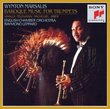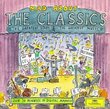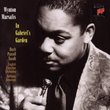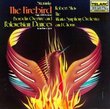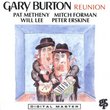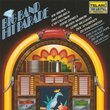| All Artists: Franz Liszt, Eugene Ormandy, Esa-Pekka Salonen, Zubin Mehta, Seiji Ozawa, Leonard Bernstein, Emanuel Ax, Hiroko Nakamura, Kazune Shimizu, Vladimir Feltsman, Philippe Entremont Title: Liszt: Greatest Hits Members Wishing: 0 Total Copies: 0 Label: Sony Original Release Date: 6/13/1995 Release Date: 6/13/1995 Genre: Classical Styles: Forms & Genres, Concertos, Etudes, Short Forms, Theatrical, Incidental & Program Music, Historical Periods, Romantic (c.1820-1910), Instruments, Keyboard, Symphonies Number of Discs: 1 SwapaCD Credits: 1 UPC: 074646459621 |
Search - Franz Liszt, Eugene Ormandy, Esa-Pekka Salonen :: Liszt: Greatest Hits
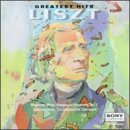 | Franz Liszt, Eugene Ormandy, Esa-Pekka Salonen Liszt: Greatest Hits Genre: Classical
AX (PNO)/FELTSMAN (PNO) MEHTA & BERNSTEIN/VARIOUS |
Larger Image |
CD DetailsSynopsis
Product Description AX (PNO)/FELTSMAN (PNO) MEHTA & BERNSTEIN/VARIOUS Similarly Requested CDs
|
CD ReviewsExcellent Joe Cota | Petaluma, California United States | 06/13/2000 (5 out of 5 stars) "This CD begins with an energetic Mephisto Waltz, flawlessly conducted with a minute and meticulous attention to detail by the illustrious Eugene Ormandy. The waltz is followed by the first momvement of Liszt's first piano concerto, a foreboding, majestic monument to ingenuity and technical challenge and brilliance, played perfectly by Emanuel Ax. After gaining the listener's attention with two intense energetic pieces, the cd cools itself with a beautiful and flowing Hungarian Rhapsody (number 2 to be precise.) The Liebstraume evokes a gentle, peaceful night scene that evolves into a thunderous, tempestous storm, raging through the night sky. Perfomred to perfection by Hiroko Nakamura. Next, to show the brilliant technician and transposer side of Liszt, is the beautiful, virtuosic, and exhillerating Etude number three (La Campanella) after Paganini, which is an amazing piano equivalent of one ofPaganini's famous and infamously difficult caprices. This is my personal favorite of the pieces, which is performed with breathtaking ease by Kazune Shimizu. This masterpiece is followed by one of Liszt's lesser piano works, a slow, soft piece that is so delicately shaded it seems to lose itself in its lack of structure, although performed quite admirably by Vladimir Feltsman. this weak spot of the CD is followed by the amazing Hungarian Fantasia for piano and orchestra, which is another of my favorite works on this CD, although it does not live up to this remark on the first listen. This track begins with gently rolling hills of melody which lead into small valleys, then, with the piano and orchestra brilliantly leading each other into the next segment, lead to majestic and stupendous mountains and cliffs. This piece has excellent segments of intense virtuosity in which the listener is left gasping in a way which only Liszt, Rachmanninoff, and Beethoven can move one. An excellent CD, well worth twice the price." Can Liszt be summarized in 8 pieces? G. Stewart | Chesapeake, VA USA | 11/19/2007 (5 out of 5 stars) "Honestly, the answer is an emphatic NO!
But, this CD presents some of Liszt's best work, performed well, recorded well, mixed well; a very good collection for someone that wants to introduce themself to the wonder that was Liszt. He forever changed music, not just for the piano, as most might believe, but classical composition as a whole was not the same after dear Franz graced this world with his presence. He was a piano virtuoso who created the concept of a piano recital. He was the man credited (with minor argument from some against) with creating the symphonic (tone) poem. But, what did Liszt do that made him really special? He grew, in talent, in style, in spectrum and in ability; and he adapted as he gained new insights in to the wonder that was and is classical composition. Mephisto Waltz is a wonder. They are, in fact, four separate waltzes, composed by Liszt over the course of his life; the first being composed around 1860 and the last around 1885. The first 2 were composed for orchestra; the remaining 2 were composed for piano. Presented here on this disc is the orchestrated version of all 4; 2 as composed by Liszt, 2 transcribed for orchestra. Piano Concerto No. 1, the first movement, is played brilliantly. This piece is almost a Piano Sonata, with virtuoso solo performances that are backed by a minimal orchestra. The piano work is beautiful and the accompanying orchestra is quiet yet complementary, with soft strings, woodwinds and brass; there is an occasional crescendo to remind you that the orchestra is working, but this piece still focuses on the piano and is a piece that shows the youthful arrogance of Liszt in his desire to display the incredible on the piano. Marvelous! Hungarian Rhapsody No. 2 seems heavily influenced, oddly enough, by Spanish themes, most likely the influence of his early influence from gypsy musical themes (the 2 main gypsy scales being Hungarian and Spanish, which are similar; I am not a music theorist, but did some research on this and found this to be a reasonable assertion) . The horn is wonderful as are the strings with the double bass and the cellos carrying the weight of the work early before allowing the violins to enter with the light and airy main theme. But the horn remains with the Spanish (or gypsy) influence throughout. No. 2 is Liszt's most famous Rhapsody and is a wonder for orchestra or on the piano. This is provided as the orchestrated version. Liebestraume (Dreams of Love) was originally composed as 3 pieces for solo piano, although the 3rd piece became synonymous with the title. All 3 pieces were composed as accompaniment or tribute to poems by 2 German poets. Provided here is the 3rd piece, played beautifully with the cascading movements of virtuoso for which Liszt was best known. This 3rd piece is further broken in to 3 sections which all remain on the main theme of the piece, but allow for varying 'takes' on the theme; the first being a slow and melodic chord based sonatine that is beautiful and heart-wrenching, the second being more intense and possessing the climactic peak of the song, and the third slowing again to the point where the chords are played, almost, as individual notes. The entire piece is staggering to hear and beautiful to experience. "La Campanella", Etude No. 3. Etudes have always been a wonder to me as I do not play piano (although I so desire to learn) because they are essentially written as practice pieces for students, but they are usually so absolutely stunning and emotional that they are anything but a piece written for a student. This particular etude (translated literally to mean 'The Little Bell') is from a series of 6 etudes (Grandes Etudes de Paganini) by Liszt and was based upon the theme in the final movement of Nicolo Paganini's Violin Concerto No. 2 in B minor. The entire piece just proves to me that, at 33, I can only hope to be able to play the easiest of etudes when I undertake piano lessons (which I do intend to do very soon). A wonderful piece, emotional and somber, morose and deeply moving. Sonetto 47 del Petrarca is from one of Liszt's most famous and amazing pieces, Annees de Pelerinage (Years of Pilgrimage). This group of 3 suites, more than any other work by Liszt, displays his maturing. The title of the suites is appropriate. I would recommend that anyone who enjoys this CD investigate the suite as a next step in learning Liszt as the compositions were completed over the course of his life and you can actually hear the differences between the First Year and the Third Year; the move from virtuoso composer who plays to dazzle, to the older, wiser composer who writes experimentally and creates harmonies that are lovely. Just as a side, check it out (the best version, I have been told, is Liszt: Annees de pelerinage, Years 1 - 3 if you are interested). This particular piece (Sonetto 47 del Petrarca) comes from the Second Year, labeled Italy, and is a tribute to the Italian scholar and poet Petrarch, credited as being the creator of humanism and the man who perfected the sonnet. The piece is a sweeping piece for solo piano that is astounding to hear. It has moments of thundering momentum, cascading retreats, and minimal chord movement. It is truly a beautiful piece and is one of my favorites by Liszt, not just from Annees de Pelerinage, but from his entire output. Hungarian Fantasy for Piano and Orchestra is a different type of piece. Essentially it is a miniature Piano Concerto, but the Piano takes the lead and the orchestra tends to repeat the themes, which are played both louder and more ornately by the pianist. The orchestral movements, especially by the woodwinds, are breath-taking. But the piano portions definitely are the highlight of the piece. It is marvelous. Finally, Les Preludes, another Symphonic (tone) poem that is amazing both in structure and in intention. Liszt spent about 6 years completing the piece and he prefaced it with a statement; "What is our Life but a series of Preludes to that unknown chant, the first solemn note of which is sounded by Death?" Liszt was a profound and deeply gifted musician, writer and artist and this statement, made in the middle years of his life, sums up the general outlook on life that he had come to embrace. The piece itself is broken in to four subsections, creating a symphony like feel, whilst still remaining a single piece. The music is somewhat somber and morose, but has highlights of uplifting melodies that soar with strings and brass. It is a piece that I am effected by every time I hear it; a true masterpiece of composition. And a wonderful tribute to a man who did so much to advance the classical genre of music. Do I have complaints? Of course! It's Franz Liszt and there are only 8 pieces included. Un Sospiro, my personal favorite piece by Liszt is glaringly absent. Liszt also transcribed many compositions by other composers and made them in to wonderful works of genius that were, in my humble opinion, completely different and worthy of appearing on a compilation of Liszt's works. A prime example would be Liszt's transcription of Schubert's "Swan Song" which contains one of the most perfect melodies I have ever heard in "Standchen" (Serenade); Schubert wrote the piece, but Liszt made it perfection when he transcribed it for Piano. But that does not take away from what you have here; a wonderful introduction to one of history's most prolific and accomplished composers. You most certainly must buy this CD if you are considering it." |

 Track Listings (8) - Disc #1
Track Listings (8) - Disc #1